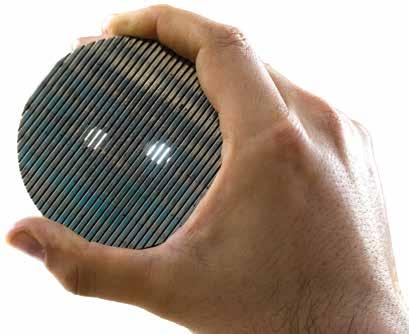
2 minute read
DARK SECRETS FROM THE FROZEN HEART OF AN INTERSTELLAR CLOUD

An international team including SwRI, Leiden University and NASA used observations from the James Webb Space Telescope (JWST) to achieve the darkest-ever view of a dense interstellar cloud. These observations revealed the composition of a virtual treasure chest of primordial ices, providing new insights into the chemical processes of one of the coldest, darkest places in the universe as well as the origins of the molecules that make up planetary atmospheres.
NASA’s JWST has a 6.5-meter-wide mirror providing remarkable spatial resolution and sensitivity, optimized for infrared light. As a result, the telescope has been able to image the densest, darkest clouds in the universe for the first time.
“These observations provide new insights into the chemical processes in one of the coldest, darkest places in the universe to better understand the molecular origins of protoplanetary disks, planetary atmospheres and other solar system objects,” said SwRI Research Scientist Dr. Danna Qasim. “The ices we observed contain only 1% of the sulfur we’re expecting. The other 99% of that sulfur is locked up somewhere else. We need to figure out where to understand how sulfur will eventually be incorporated into the planets that may host life.”
In the study, Qasim and colleagues propose that the sulfur may be locked in reactive minerals like iron sulfide.
“Iron sulfide has been detected in the accretion disks of young stars and in samples returned from comets. It’s also the most common sulfide mineral in lunar rocks,” Qasim said. “If sulfur is locked up in these minerals, that could explain the low levels of sulfur in interstellar ices, which has implications for where sulfur is stored in our solar system. For example, sulfur in the atmosphere of Venus may have originated from interstellarinherited minerals.”
SwRI has created a more effective method to evaluate changes in sand control screens used in oil and gas production wells. Using accelerated life erosion testing, the new method pinpoints the location of erosion and can be used to evaluate other equipment in harsh environments.
In oil and gas production wells, sand screens keep formation and fracturing sand in the reservoir while allowing fluids to be produced. Fine sands, smaller than the screen gaps, periodically pass through the screens, causing erosion that can eventually lead to screen failure. Sand produced with oil and gas in a well can erode the equipment between the reservoir and the surface, causing costly production halts to repair or replace damaged components.
“Measuring erosion in sand screens is challenging. Current methods use a single point value to describe erosion that differs across various regions,” said Jessica Brysch, an assistant program manager in SwRI’s Fluids Engineering Department. “These methods identify only the largest gap associated with erosive flow through a sand screen. Our method identifies each gap.”
Using internal research funding, SwRI developed a graphical approach to express sand screen erosion, providing a more complete picture of the damage. The method examines both the screen and base pipe layers.
“Using microscopy, we have developed a novel visual technique, providing a spatial understanding of where erosion is occurring,” said Luis Gutierrez, a research engineer in SwRI’s Fluids Engineering Department. “Our method maps the magnitude and location of erosion experienced in both the screen and base pipe layer.”
SwRI has extended the visualization methods to other types of equipment to quantify erosion in harsh environments. The technique can also help predict component life under specific well conditions, rather than waiting for equipment to fail.








